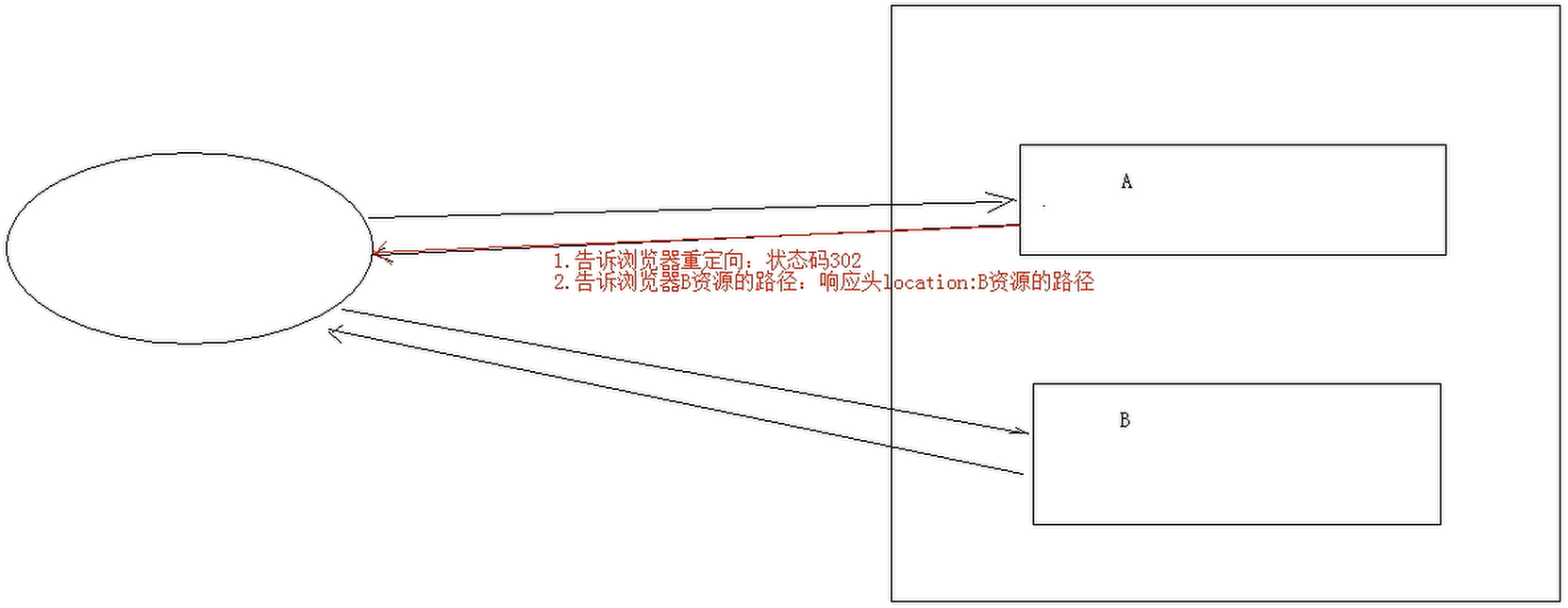HTTP协议:
1. 请求消息:客户端发送给服务器端的数据
* 数据格式:
1. 请求行
2. 请求头
3. 请求空行
4. 请求体
2. 响应消息:服务器端发送给客户端的数据
* 数据格式:
1. 响应行
1. 组成:协议/版本 响应状态码 状态码描述
2. 响应状态码:服务器告诉客户端浏览器本次请求和响应的一个状态。
1. 状态码都是3位数字
2. 分类:
1. 1xx:服务器就收客户端消息,但没有接受完成,等待一段时间后,发送1xx多状态码
2. 2xx:成功。代表:200
3. 3xx:重定向。代表:302(重定向),304(访问缓存)
4. 4xx:客户端错误。
* 代表:
* 404(请求路径没有对应的资源)
* 405:请求方式没有对应的doXxx方法
5. 5xx:服务器端错误。代表:500(服务器内部出现异常)
2. 响应头:
1. 格式:头名称: 值
2. 常见的响应头:
1. Content-Type:服务器告诉客户端本次响应体数据格式以及编码格式
2. Content-disposition:服务器告诉客户端以什么格式打开响应体数据
* 值:
* in-line:默认值,在当前页面内打开
* attachment;filename=xxx:以附件形式打开响应体。文件下载
3. 响应空行
4. 响应体:传输的数据
* 响应字符串格式
HTTP/1.1 200 OK
Content-Type: text/html;charset=UTF-8
Content-Length: 101
Date: Wed, 06 Jun 2018 07:08:42 GMT
<html>
<head>
<title>$Title$</title>
</head>
<body>
hello , response
</body>
</html>
Response对象
一、功能:设置响应消息
1. 设置响应行
1. 格式:HTTP/1.1 200 ok
2. 设置状态码:setStatus(int sc)
2. 设置响应头:
1 | setHeader(String name, String value) |
3. 设置响应体:
* 使用步骤:
1. 获取输出流
* 字符输出流:PrintWriter getWriter()
* 字节输出流:ServletOutputStream getOutputStream()
2. 使用输出流,将数据输出到客户端浏览器
二、案例:
1. 完成重定向
重定向:资源跳转的方式

代码实现:1
2
3
4
5
6
7
8//1. 设置状态码为302
response.setStatus(302);
//2.设置响应头location
response.setHeader("location","/day15/responseDemo2");
//简单的重定向方法
response.sendRedirect("/day15/responseDemo2");
重定向的特点:redirect
1. 地址栏发生变化
2. 重定向可以访问其他站点(服务器)的资源
3. 重定向是两次请求。不能使用request对象来共享数据
转发的特点:forward
1. 转发地址栏路径不变
2. 转发只能访问当前服务器下的资源
3. 转发是一次请求,可以使用request对象来共享数据
上面这两个遇到面试题就可能被问到:forward 和 redirect 区别
路径写法:
1. 路径分类
1. 相对路径:通过相对路径不可以确定唯一资源
* 如:./index.html
* 不以/开头,以.开头路径
* 规则:找到当前资源和目标资源之间的相对位置关系
* ./:当前目录
* ../:后退一级目录
2. 绝对路径:通过绝对路径可以确定唯一资源
* 如:http://localhost/day15/responseDemo2 /day15/responseDemo2
* 以/开头的路径
* 规则:判断定义的路径是给谁用的?判断请求将来从哪儿发出
* 给客户端浏览器使用:(重定向是给浏览器用)
需要加虚拟目录(项目的访问路径)
* 建议虚拟目录动态获取:request.getContextPath()
* <a> , <form> 重定向...
* 给服务器使用:(请求转发是给服务器端使用的)
不需要加虚拟目录
* 转发路径
2. 服务器输出字符数据到浏览器
* 步骤:
1. 获取字符输出流
2. 输出数据
* 注意:
* 乱码问题:
1. PrintWriter pw = response.getWriter();获取的流的默认编码是ISO-8859-1
2. 设置该流的默认编码
3. 告诉浏览器响应体使用的编码
//简单的形式,设置编码,是在获取流之前设置
1 | response.setContentType("text/html;charset=utf-8"); |
1 | ("/responseDemo4") |
3. 服务器输出字节数据到浏览器
* 步骤:
1. 获取字节输出流
2. 输出数据
1 |
|
4. 验证码
1. 本质:图片
2. 目的:防止恶意表单注册
1 | package cn.zenner.web.servlet; |
1 |
|
ServletContext对象:
1. 概念
代表整个web应用,可以和程序的容器(服务器)来通信
2. 获取:
1. 通过request对象获取
request.getServletContext();
2. 通过HttpServlet获取
this.getServletContext();
3. 功能:
(1) 获取MIME类型:
* MIME类型:在互联网通信过程中定义的一种文件数据类型
* 格式: 大类型/小类型 text/html image/jpeg
* 获取:String getMimeType(String file)
(2) 域对象:共享数据
1. setAttribute(String name,Object value)
2. getAttribute(String name)
3. removeAttribute(String name)
* ServletContext对象范围:所有用户所有请求的数据
(3) 获取文件的真实(服务器)路径
1 | 1. 方法:String getRealPath(String path) |
案例:
* 文件下载需求:
1. 页面显示超链接
2. 点击超链接后弹出下载提示框
3. 完成图片文件下载
* 分析:
1. 超链接指向的资源如果能够被浏览器解析,则在浏览器中展示,如果不能解析,则弹出下载提示框。不满足需求
2. 任何资源都必须弹出下载提示框
3. 使用响应头设置资源的打开方式:
* content-disposition:attachment;filename=xxx
* 步骤:
1. 定义页面,编辑超链接href属性,指向Servlet,传递资源名称filename
2. 定义Servlet
1. 获取文件名称
2. 使用字节输入流加载文件进内存
3. 指定response的响应头: content-disposition:attachment;filename=xxx
4. 将数据写出到response输出流
1 | package cn.zenner.web.download; |
* 问题:
* 中文文件问题
* 解决思路:
1. 获取客户端使用的浏览器版本信息
2. 根据不同的版本信息,设置filename的编码方式不同